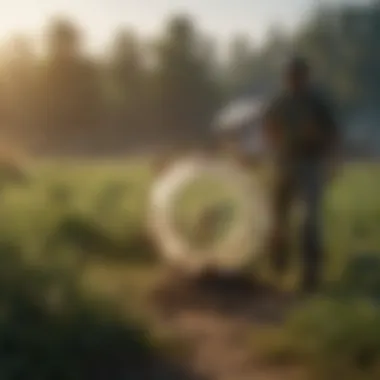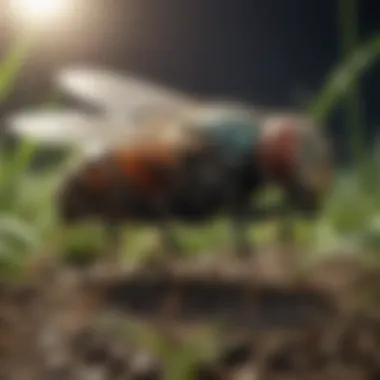Farm Fly Catcher: Solutions for Sustainable Pest Control


Intro
In the realm of agriculture, managing pests effectively while cultivating sustainably is a critical concern. Farmers seek solutions that are not only effective but also environmentally friendly, ensuring the viability of their crops and the health of surrounding ecosystems. One such solution gaining popularity is the farm fly catcher. This article examines the role of fly catchers in sustainable pest management, highlighting various designs, deployment techniques, and the ecological considerations surrounding their use. Through this exploration, we aim to equip farmers and horticulturists with practical strategies for implementing effective fly-catching systems.
Latest Trends in Agriculture
Overview of Current Trends
The agricultural sector is witnessing notable trends that steer towards sustainability and efficiency. With increasing consumer demand for organic produce and the challenges posed by pests, innovative pest management techniques are on the rise. The rise of integrated pest management systems is one significant trend linking fly catchers with broader agricultural practices. This approach recognizes the importance of combining various methods for controlling pests, thus minimizing risks associated with over-reliance on chemical pesticides.
Impact of Technology on Farming Practices
Technology plays a transformative role in modern farming. Today's farmers utilize various technological advancements such as smart sensors and drones for monitoring crops and pests. Fly catchers have also evolved, with designs that incorporate these innovations. For instance, smart fly traps can use sensors to monitor pest activity and provide real-time data. This allows farmers to more effectively manage pest populations, improving crop yields while reducing environmental impact.
Sustainable Practices: Towards a Greener Future
Importance of Sustainability in Agriculture
Sustainability in agriculture is essential for several reasons. It ensures that farming practices do not compromise the economy, environment, or society. Implementing sustainable practices helps in preserving natural resources, reducing carbon footprints, and promoting biodiversity. By adopting measures like fly catchers, farmers promote a reduction in pesticide use and support overall ecosystem health.
Methods for Sustainable Farming
- Organic Pest Control: Utilizing non-toxic methods to manage pests, such as encouraging natural predators or employing fly catchers.
- Crop Rotation: Changing the types of crops grown in a specific area to disrupt pest cycles.
- Companion Planting: Planting specific crops together can deter pests naturally.
- Soil Health Management: Maintaining soil quality through organic amendments and cover crops.
Gardening Techniques and Tips
Essential Gardening Tools and Equipment
Successful gardening requires the right tools. Some essential tools include:
- Hand Trowel: Great for planting and transplanting.
- Pruning Shears: Helpful for trimming plants and bushes.
- Garden Hoe: Effective for cultivating soil.
- Fly Catcher Systems: Incorporating these into your garden can significantly reduce pest populations.
Seasonal Gardening Practices
Understanding seasonal gardening practices is crucial for pest management. During spring, ensure to monitor for pests early in the growing season. In summer, prioritize the deployment of fly catchers as pests are most active. The fall season can be utilized for cleaning up debris and ensuring structures are optimized for the next growing cycle.
By adopting effective farm fly catchers and sustainable practices, farmers can uphold crop health and contribute positively towards environmental conservation.
Epilogue
In summary, the integration of farm fly catchers into sustainable agricultural practices is a necessary step towards modern farming. As farmers embrace these innovative solutions, they can improve their pest management strategies while promoting a healthier ecosystem. Understanding the tools, technologies, and methods at your disposal can lead to more effective farming outcomes.
Preface to Farm Fly Catchers
The management of pests in agriculture demands attention. Among the various strategies available, farm fly catchers have emerged as a significant solution. These devices are tailored to capture and mitigate fly populations that threaten crops and livestock. Understanding their role is essential for sustainable agricultural practices.
Defining Farm Fly Catchers
Farm fly catchers are specialized tools designed to trap flies effectively. They can come in several forms, including mechanical traps and electronic devices. Each type has distinct operational mechanisms aimed at luring and retaining flies. Most farm fly catchers utilize bait or light to draw flies in, then prevent them from escape once caught. This simple yet efficient design can dramatically reduce pest populations in a farming environment.
Importance in Agriculture
The relevance of farm fly catchers in agriculture cannot be overstated. First, they help in controlling the populations of flies known to transmit diseases to livestock and crops. This is crucial for maintaining healthy animal stocks and producing safe food products. Additionally, by lowering fly density, farm fly catchers can improve crop yields. Research suggests that farms employing these devices experience less crop damage due to reduced pest interference.


Furthermore, using farm fly catchers contributes to sustainable farming practices. They present an eco-friendly alternative to chemical pesticides, which can have harmful effects on ecosystems and human health. With the increased emphasis on organic farming, many growers are looking for solutions that do not rely on synthetic chemicals. Farm fly catchers, therefore, align well with this trend, offering a viable pest management strategy.
"Sustainable pest management begins with understanding and implementing effective non-chemical solutions."
Types of Farm Fly Catchers
Farm fly catchers play a crucial role in pest management. They provide solutions that are not only effective but also sustainable. Understanding the various types of farm fly catchers can aid farmers in selecting the right methods for their specific needs. Each type comes with its own set of benefits and considerations, contributing differently to pest control strategies. This guide will explore these types, allowing for better application of the best practices in agriculture.
Mechanical Fly Traps
Mechanical fly traps operate without chemicals, relying on designs that physically capture flies. They are simple devices, often made from materials like plastic or metal, and can be reused. This makes them cost-effective in the long run. The traps may feature rotating arms or adhesive surfaces that entrap flies when they come into contact.
Key benefits of mechanical traps include:
- Non-toxic: No harmful chemicals are involved, making them safe to use around food and livestock.
- Environmentally friendly: These traps do not contribute to chemical pollution.
- Durability: With proper maintenance, mechanical traps can last for a long time.
Farmers should consider their placement for maximum effectiveness. Mechanical traps should be strategically located near breeding sites or areas with high fly activity to enhance their performance.
Sticky Traps
Sticky traps are another effective option. These traps are coated with a sticky substance that captures flies upon landing. They come in various shapes, such as sheets or rolls, and can be hung in different locations on the farm.
Advantages of using sticky traps include:
- Visibility: They show the level of infestation, allowing farmers to monitor pest levels.
- Ease of use: Simple to install and maintain, with no need for special skills.
- Cost-effectiveness: Generally cheaper than other methods, making them accessible for small-scale farmers.
However, farmers must ensure that sticky traps are replaced when saturated or dirty, as their efficacy diminishes over time.
Baited Fly Traps
Baited fly traps attract flies using food substances or other enticing agents. Common baits include sugar solutions or protein lures. Once attracted, flies are trapped and cannot escape.
These traps are particularly useful in areas where food waste generates fly populations. The key advantages are:
- Targeted attracting: They can lure specific fly species, making them more effective against particular pests.
- High trapping efficiency: Increased effectiveness when compared to non-baited traps, especially in the right conditions.
Farmers should regularly check and replace bait to maintain the traps’ effectiveness. Additionally, proper placement is essential to maximize outreach to problem areas.
Electric Fly Traps
Electric fly traps utilize light and heat to attract flies, which are then zapped by electrical grids. They are often seen as high-tech solutions for pest management.
The benefits of electric traps may include:
- Highly effective: They can eliminate large numbers of flies quickly.
- Low maintenance: Require minimal upkeep; only periodic cleaning and checking of the electric components are needed.
- Non-toxic method: Like mechanical traps, they do not use harmful chemicals.
However, placement is critical. Experts recommend keeping these traps away from food sources to avoid attracting more flies and ensuring they are in well-lit areas to attract effectively.
Effectiveness of Farm Fly Catchers
The effectiveness of farm fly catchers is a crucial aspect that underpins sustainable pest management strategies in agriculture. Understanding how these devices perform in real-world conditions helps farmers make informed decisions. Numerous factors come into play concerning how well these traps work in reducing fly populations. Examining the efficacy studies and the various factors that influence results provides a more comprehensive perspective on their utility.
Efficacy Studies
Efficacy studies are essential for assessing the performance of farm fly catchers. Various research efforts focus on comparing different types of traps to determine which are most effective. These studies often involve field trials where specific traps are deployed under controlled conditions.


- Trap Types and Performance: Researchers frequently analyze differences in effectiveness among mechanical traps, sticky traps, baited traps, and electric traps. Each of these types has its unique attributes, impacting how well they catch flies.
- Data Collection: Studies usually measure the number of flies captured over a defined period. This quantifiable data provides key insights into which traps yield higher catch rates.
- Environmental Conditions: The effectiveness can also vary with changes in environmental conditions like temperature, humidity, and even the presence of other competing attractants.
From these studies, it is clear that efficacy can greatly vary not only between types but also with environmental factors, thus providing critical information for farmers when choosing a farm fly catcher.
Factors Influencing Results
Several factors influence the results of effectiveness studies related to farm fly catchers. Understanding these can improve the application of these devices significantly.
- Placement Strategy: How and where trap is placed can affect catch rates. If positioned incorrectly, traps may not perform as expected. Optimal placement is vital for maximizing effectiveness.
- Attractants: Some traps use different types of attractants. The quantity and quality of attractants highly influence fly capture rates. Factors such as the age of bait and its composition can draw more flies or, conversely, deter them.
- Fly Species: Different fly species may respond differently to various traps. Identifying the predominant fly species in a given area is crucial for selecting the most appropriate trap type.
- Maintenance: Regular monitoring and maintenance are necessary to ensure the traps continue to work effectively. Clogged traps or expired bait lead to substantial decreases in capture efficiency.
By considering these influential factors, farmers can tailor their approach to pest management, ensuring better outcomes in fly control.
Best Practices for Using Farm Fly Catchers
Best practices for using farm fly catchers are crucial for achieving optimal results in sustainable pest management. Proper deployment and maintenance of these devices enhance their effectiveness, minimize waste, and ultimately contribute to better agricultural health. Understanding the strategic placement and the ongoing maintenance needs of fly catchers are vital for farmers, horticulturists, and agricultural specialists aiming to control pest populations effectively.
Placement Strategies
Placement strategies are fundamental in maximizing the efficacy of farm fly catchers. Different types of fly catchers may require specific locations based on their design and the species of flies they target.
- Identify hotspots: Start by analyzing fly activity areas such as near feed storage, waste disposal sites, or watering troughs. Flies are generally attracted to these locations due to their access to food or breeding conditions.
- Height considerations: Different fly species have variable flight patterns. It is necessary to install fly catchers at the appropriate height. For example, indoor traps might be more effective when positioned at eye level, while outdoor traps may require height adjustments depending on vegetation.
- Distance from attractions: Place traps at strategic distances from sources of attraction. Traps too close may not work effectively, while those placed too far may not catch the flies that venture from breeding sites. A distance of around ten feet is generally recommended.
- Avoid obstructions: Ensure that traps are clear of obstacles. Dense foliage or barriers can hinder the flies' approach to traps, reducing their efficiency.
- Environmental factors: Take into account factors like wind and sunlight. Wind can affect trap performance, particularly for sticky traps. Traps should be placed where they are shielded from heavy winds but still exposed enough to attract flies.
By paying more attention to these placement strategies, farmers can improve their chances of effectively managing fly populations.
Monitoring and Maintenance
Effective monitoring and maintenance of farm fly catchers are vital for ensuring their longevity and functionality. Regular checks can significantly contribute to sustainable pest management.
- Routine inspections: Establish a routine for inspecting traps. This includes checking for captured flies, adherence of sticky surfaces, and overall trap integrity. Regular intervals, such as weekly checks, provide insight into trap performance and pest levels.
- Cleanliness: Maintain cleanliness around the traps. This minimizes additional attractants and helps to keep the traps focused on their intended purpose. Remove decaying organic matter and ensure that surrounding areas don’t host excessive waste or food residues.
- Seasonal adjustments: As conditions change throughout the seasons, so do the patterns of pest activity. Adjust the type and number of traps according to seasonal fly behavior. This may mean increasing trap density during peak fly seasons.
- Proper disposal: Understand how to dispose of dead flies and spent traps properly. Adhere to local regulations regarding disposal methods for organic waste. This action not only supports hygiene but also prevents attracting more pests.
- Record keeping: Keep a thorough maintenance log for traps. Note their conditions, capture rates, and any adjustments made during the monitoring period. This data can help identify trends and improve future pest management strategy.
Regular monitoring and maintenance of fly catchers can enhance their effectiveness, ensuring that farmers do not become overwhelmed by pest populations.
Through implementing these best practices, crops can benefit from reduced pest pressure, contributing to healthier production and a more sustainable agricultural environment.
Ecological Impact of Farm Fly Catchers
The implementation of farm fly catchers plays a crucial role in shaping the ecological dynamics of agricultural environments. By effectively managing fly populations, these devices can enhance not only crop health but also promote biodiversity within farming ecosystems. Farming is not just about producing crops; it is also about maintaining a delicate balance between various organisms within the environment. Understanding the ecological impact of these catchers is essential for any farmer looking to utilize sustainable practices.
Benefits to Biodiversity
Farm fly catchers have positive implications for biodiversity. They aid in controlling pest populations, which in turn helps in protecting beneficial insects that contribute to the ecosystem. Insects such as pollinators are vital for crop production. By reducing the number of troublesome flies, these catchers allow for an environment where pollinators can thrive without competition or threat from pest species.
Some specific benefits include:
- Protection of Pollinators: By targeting specific pests, farm fly catchers help to ensure that pollinators such as bees and butterflies can safely access flowers and crops.
- Encouragement of Natural Predators: Effective pest control fosters conditions that enable natural predators, like birds and certain insects, to flourish. These predators will help keep other pest populations in check.
- Healthier Soil Dynamics: With a balanced ecosystem, soil health can also improve. Diverse organisms contribute to nutrient cycling, which is essential for sustainable crop growth.
Potential Risks
Despite the advantages, it is vital to acknowledge potential risks associated with farm fly catchers. Implementing these traps without proper knowledge can disrupt local ecosystems. Here are some points to consider:
- Non-Target Catch: Some traps may unintentionally capture beneficial insects along with pests. This can lead to a decrease in important species, affecting ecological balance.
- Chemical Exclusion: If baited traps use chemical attractants, there is a risk that these could harm non-target organisms in the vicinity.
- Habitat Disruption: Alterations made to accommodate traps might negatively impact local wildlife habitats. Careful planning is necessary to avoid such circumstances.
In summary, while farm fly catchers present an effective tool for pest management, it is essential to consider their ecological impact carefully. Awareness and strategic implementation can maximize benefits while minimizing risks, supporting both agricultural production and biodiversity.
Challenges in Implementation


Implementing farm fly catchers brings certain challenges, which can affect their effectiveness in pest management. Understanding these challenges is crucial for ensuring that farmers and agricultural enthusiasts make informed decisions. Addressing cost considerations and labor requirements are key elements that influence how effectively these solutions can be integrated into existing pest management strategies.
Cost Considerations
The financial aspect of farm fly catchers cannot be overlooked. The initial investment can vary significantly depending on the type of trap selected and the scale of implementation. Mechanical fly traps might require a moderate upfront cost with minimal ongoing maintenance. In contrast, electric fly traps can involve higher costs due to both the equipment and electricity usage.
Farmers need to analyze their budget to determine which traps align with their financial situations. It's not just the purchase of equipment; there may also be additional costs related to bait, maintenance, and replacement over time. Small growers may find it easier to justify the expense of sticky traps, while larger operations could benefit from the economies of scale offered by bulk purchasing or investing in more advanced systems.
Ultimately, the cost effectiveness of using fly catchers must be evaluated not just on purchase price but also on their overall impact on pest populations and crop yields. Decisions should be data-driven, looking at longer-term savings and benefits rather than just initial expenditures.
Labor Requirements
In addition to costs, labor is another key factor when implementing farm fly catchers. Effective use of these devices often requires consistent monitoring and maintenance. Depending on the type of trap, this could mean regularly checking sticky traps or ensuring that electric traps remain powered and functional.
Farmers may need to allocate additional labor resources to manage these tasks. It's essential to train staff on identifying when traps are full or need replacement, as neglect can reduce the effectiveness of pest control efforts.
In regions where labor is scarce, this can pose a significant challenge. Not only does this lead to increased costs for personnel, but it can also delay pest management efforts, allowing infestations to worsen. Some farm owners might consider automating certain processes or utilizing technology to help ease these labor demands.
Epilogue
In conclude, while farm fly catchers provide promising solutions for sustainable pest management, their implementation is not without challenges. Careful consideration of costs and labor requirements is necessary for successful integration into agricultural practices. By planning ahead and being aware of these factors, farmers can harness the benefits of these systems effectively.
Future of Farm Fly Catchers
The future trajectory of farm fly catchers is marked by significant opportunities for improvement and innovation. As agriculture continues to evolve with increasing demands for sustainability, these tools will play a central role in pest management strategies. The integration of new technologies and advanced analytical methods is crucial. This will offer farmers robust options for reducing dependency on chemical pesticides while maintaining crop health. Future developments will likely focus on enhancing efficacy, efficiency, and environmental safety, providing both economic and ecological benefits.
Technological Advancements
Technological advancements are vital for the future of farm fly catchers. These innovations will facilitate the creation of more effective traps and methods for monitoring pest populations. For instance, the development of biodegradable materials for traps could minimize environmental impact. Furthermore, improvements in design and functionality can enhance catch rates.
Advancements in sensors and connectivity can allow for real-time monitoring of traps. Farmers will have access to data about fly populations, which will inform their pest control strategies. This can lead to more timely interventions and better resource allocation. Moreover, automating data collection can reduce labor costs and improve efficiency.
- Smart traps: Utilizing IoT technology to create smart traps could revolutionize pest control. These traps could send alerts when full and provide data analytics for trends.
- Remote control systems: Remote management of fly traps will enable farmers to monitor conditions from afar, allowing for efficient operation.
Integrating AI and Data Analysis
The integration of AI and data analysis in the management of farm fly catchers holds immense promise. AI can enhance decision-making processes through predictive analytics, helping to forecast pest outbreaks based on environmental conditions. This can assist in preemptive actions, reducing infestation risks before they escalate.
Farmers can utilize data analysis to assess the performance of various types of fly catchers. By analyzing catch data over time, it becomes possible to identify which traps are most efficient in specific conditions. This level of insight can lead to better strategies tailored to individual farm environments.
- Machine learning algorithms can be employed to refine data collection and enhance the predictive capabilities of pest control programs.
- Visualization tools can make it easier for farmers to understand data and spot trends, empowering them to make informed decisions proactively.
The future of farm fly catchers lies in their ability to adapt to new technologies, making them smarter and more effective for sustainable pest management.
End
The conclusion of this article synthesizes the significant points on farm fly catchers and their role in sustainable pest management within agriculture. This section serves as a final summation of the benefits and practical implications of utilizing farm fly catchers effectively. Understanding the complexity and issues surrounding pest control is crucial for farmers looking to maintain their crops while reducing ecological footprints.
Summary of Benefits
Farm fly catchers offer various benefits that enhance sustainable agricultural practices:
- Reduction of Chemical Use: They minimize reliance on chemical pesticides, decreasing the risk of harmful residues in food as well as in the environment.
- Cost-Effectiveness: Once implemented, fly catchers can lead to significant savings by lowering pest management costs over time.
- Enhanced Crop Health: By effectively managing fly populations, the overall health of crops improves, leading to better yields.
- Biodiversity Protection: Farm fly catchers help maintain a healthy ecosystem by avoiding the side effects of broad-spectrum pesticides, thus protecting beneficial insects.
Call to Action for Sustainable Practices
Embracing the use of farm fly catchers calls for immediate action from all farmers and agricultural enthusiasts. Here are some steps to consider:
- Educate Yourself: Farmers should continue to learn about various types of fly catchers and select those that best fit their specific situations.
- Participate in Community Workshops: Join local agricultural groups that focus on sustainable practices to share insights and findings about effective pest management.
- Monitor Results: Keep track of fly populations and crop health on a systematic basis, adjusting tactics according to effectiveness.
- Collaborate with Experts: Reach out to agricultural extension services or universities that can provide research-backed recommendations.
Through these actions, not only can farmers improve their pest management practices, but they can also contribute to a broader initiative toward sustainability in agriculture.







